Catarman | |
|---|---|
| Municipality of Catarman | |
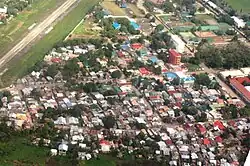 Aerial view of Catarman | |
 Flag  Seal | |
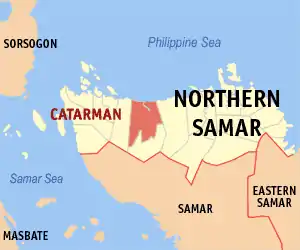 Map of Northern Samar with Catarman highlighted | |
OpenStreetMap | |
.svg.png.webp) Catarman Location within the Philippines | |
| Coordinates: 12°29′58″N 124°37′58″E / 12.4994°N 124.6328°E | |
| Country | Philippines |
| Region | Eastern Visayas |
| Province | Northern Samar |
| District | 1st district |
| Barangays | 55 (see Barangays) |
| Government | |
| • Type | Sangguniang Bayan |
| • Mayor | Francisco Aurelio E. Rosales III |
| • Vice Mayor | Francisco C. Rosales Jr. |
| • Representative | Paul R. Daza |
| • Councilors | List |
| • Electorate | 61,074 voters (2022) |
| Area | |
| • Total | 464.43 km2 (179.32 sq mi) |
| Elevation | 15 m (49 ft) |
| Highest elevation | 142 m (466 ft) |
| Lowest elevation | −1 m (−3 ft) |
| Population (2020 census)[3] | |
| • Total | 97,879 |
| • Density | 210/km2 (550/sq mi) |
| • Households | 20,836 |
| Demonym | Catarmanon |
| Economy | |
| • Income class | 1st municipal income class |
| • Poverty incidence | 30.27 |
| • Revenue | ₱ 458.3 million (2020) |
| • Assets | ₱ 962 million (2020) |
| • Expenditure | ₱ 422.2 million (2020) |
| Service provider | |
| • Electricity | Northern Samar Electric Cooperative (NORSAMELCO) |
| Time zone | UTC+8 (PST) |
| Zip Code | 6400 |
| PSGC | |
| IDD : area code | +63 (0)55 |
| Native languages | Waray Tagalog |
| Website | www |
Catarman, officially the Municipality of Catarman (Waray [Ninorte Samarnon]: Bungto san Catarman; Tagalog: Bayan ng Catarman), is a 1st class municipality and capital of the province of Northern Samar, Philippines. According to the 2020 census, it has a population of 97,879 people.[3]
It is the largest municipality in terms of land area and population in the province. It is the commercial, educational, financial, political and government center of the province.
History
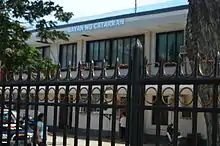
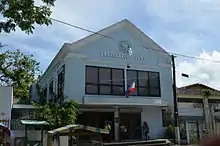
Before the coming of the Spaniards, Catarman (also known as Calatman or Cataruman) was a settlement by the mouth of the river of the same name in the region called Ibabao. The Spanish Conquistadors applied the term Ibabao to the northern part of Samar island when it established its civil government. The similarities in the vocabularies and pronunciation of the dialects of these areas traces them to a common root as a people.
The town was one of the 13 villages and settlements and adopted as pueblos by the Spaniards in Samar Island and was one of the settlements in the northern parts of the island. The pueblo was named Calatman and was one of the pueblos in the Visayan islands, then collectively referred to as Islas de Pintados [Island of the Painted Ones].
In 1974, Catarman was made the center of the episcopal see of the then newly established Roman Catholic Diocese of Catarman comprising the Northern Samar province, with the Our Lady of the Annunciation Parish Church as the designated cathedral.[5]
Cityhood
In 2003, its application for cityhood was deterred after officials of the neighboring of towns Bobon, Lope de Vega, and Mondragon opposed the planned Catarman City conglomeration, which was necessary to meet the criteria for the approval of its bid for cityhood. Another bill was filed converting the Municipality of Catarman into a component city of Northern Samar but is still pending with the Committee on Local Government in the House of Representatives since July 2010. The rise of establishments and banking institutions has swiftly came and filled the spaces of Catarman that paved the way for it to become competitive.
In the 19th Congress of the Philippines, house bills were filed by various representatives which seeks Catarman including other capital towns of provinces with no current component cities, independent component cities or highly urbanized cities to automatically convert into cities.[6][7][8]
Geography
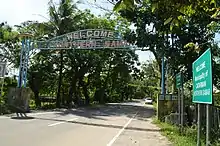
.jpg.webp)
Catarman lies on the northern part of Samar Island, bounded to the east by Mondragon, to the west by Bobon, to the south by Lope de Vega, to the southwest by Calbayog City, and to the north by the Philippine Sea.
On the Pacific coast are flat lowlands with the interior characterized by outlying low hills. Mount Puyao in Barangay Liberty is the highest peak in the area. The Catarman River, a major provincial river, divides the eastern and the western parts of the town. It is fed by the Paticua, Hibulwangan, Mahangna, Tura, and Danao creeks together with lesser prominent estuaries.
Barangays
Catarman is politically subdivided into 55 barangays. Each barangay consists of puroks and some have sitios.
- Acacia (pob.)
- Aguinaldo
- Airport Village (pob.)
- Bangkerohan
- Baybay (pob.)
- Bocsol
- Cabayhan
- Cag-abaca
- Cal-igang
- Calachuchi (pob.)
- Casoy (pob.)
- Cawayan
- Cervantes
- Cularima
- Daganas
- Dalakit
- Doña Pulqueria
- Galutan
- Gebalagnan
- Gibulwangan
- Guba
- Hinatad
- Imelda
- Ipil-ipil (pob.)
- Jose Abad Santos (pob.)
- Jose P. Rizal (pob.)
- Lapu-lapu (pob.)
- Liberty
- Libjo
- Mabini
- Mabolo (pob.)
- Macagtas
- Malvar
- McKinley
- Molave (pob.)
- Narra (pob.)
- New Rizal
- Old Rizal
- Paticua
- Polangi
- Quezon
- Salvacion
- Sampaguita (pob.)
- San Julian
- San Pascual
- Santol (pob.)
- Somoge
- Talisay (pob.)
- Tinowaran
- Trangue
- UEP Zone I
- UEP Zone II
- UEP Zone III
- Washington
- Yakal (pob.)
Climate
| Climate data for Catarman, Northern Samar (1991–2020, extremes 1949–2020) | |||||||||||||
|---|---|---|---|---|---|---|---|---|---|---|---|---|---|
| Month | Jan | Feb | Mar | Apr | May | Jun | Jul | Aug | Sep | Oct | Nov | Dec | Year |
| Record high °C (°F) | 34.2 (93.6) |
34.0 (93.2) |
35.4 (95.7) |
37.2 (99.0) |
37.7 (99.9) |
38.0 (100.4) |
36.7 (98.1) |
37.1 (98.8) |
37.5 (99.5) |
35.5 (95.9) |
36.0 (96.8) |
34.3 (93.7) |
38.0 (100.4) |
| Mean daily maximum °C (°F) | 29.3 (84.7) |
29.9 (85.8) |
30.7 (87.3) |
32.0 (89.6) |
33.1 (91.6) |
32.9 (91.2) |
32.3 (90.1) |
32.8 (91.0) |
32.6 (90.7) |
31.6 (88.9) |
30.8 (87.4) |
29.9 (85.8) |
31.5 (88.7) |
| Daily mean °C (°F) | 26.0 (78.8) |
26.2 (79.2) |
26.7 (80.1) |
27.6 (81.7) |
28.5 (83.3) |
28.4 (83.1) |
28.1 (82.6) |
28.5 (83.3) |
28.2 (82.8) |
27.6 (81.7) |
27.1 (80.8) |
26.6 (79.9) |
27.5 (81.5) |
| Mean daily minimum °C (°F) | 22.7 (72.9) |
22.5 (72.5) |
22.6 (72.7) |
23.2 (73.8) |
23.9 (75.0) |
24.0 (75.2) |
23.9 (75.0) |
24.1 (75.4) |
23.9 (75.0) |
23.6 (74.5) |
23.5 (74.3) |
23.3 (73.9) |
23.5 (74.3) |
| Record low °C (°F) | 16.9 (62.4) |
17.2 (63.0) |
17.6 (63.7) |
19.0 (66.2) |
20.0 (68.0) |
20.0 (68.0) |
20.8 (69.4) |
20.6 (69.1) |
19.4 (66.9) |
19.9 (67.8) |
17.8 (64.0) |
18.2 (64.8) |
16.9 (62.4) |
| Average rainfall mm (inches) | 520.1 (20.48) |
310.5 (12.22) |
312.4 (12.30) |
152.5 (6.00) |
162.9 (6.41) |
217.3 (8.56) |
221.9 (8.74) |
167.7 (6.60) |
205.8 (8.10) |
331.9 (13.07) |
457.8 (18.02) |
689.9 (27.16) |
3,750.7 (147.67) |
| Average rainy days (≥ 0.1 mm) | 21 | 15 | 15 | 11 | 10 | 13 | 14 | 11 | 12 | 17 | 22 | 24 | 185 |
| Average relative humidity (%) | 89 | 87 | 86 | 84 | 83 | 84 | 85 | 83 | 84 | 86 | 88 | 89 | 86 |
| Source: PAGASA[9][10] | |||||||||||||
Demographics
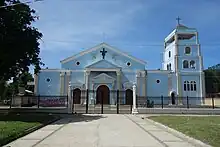
|
|
| ||||||||||||||||||||||||||||||||||||||||||||||||||||||
| Source: Philippine Statistics Authority[11][12][13][14] | ||||||||||||||||||||||||||||||||||||||||||||||||||||||||
Economy

Transportation
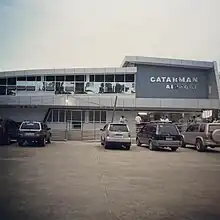

There is only one airline operating through the Catarman National Airport (IATA: CRM) coming from and going to Manila: PAL Express. Flights are frequently booked out well in advance and a one way ticket from Manila costs between PhP3,000 and PhP8,000 unless booked well in advance. Pedicabs, commonly known as "padyak" and motorized tricycles are the means of transportation within the town, and going to the Land Transport Central Terminal while multicabs, jeepneys, and vans are the means of transportation from this Terminal to neighboring and distant towns within and outside the province. Several vans and buses companies are also operating from the town going to Manila or Tacloban city and vice versa.
Education
Catarman is home to the University of Eastern Philippines, the first state university in the Visayas and the largest university by student population and curriculum in Eastern Visayas. The university has satellite campuses in the province, one in Laoang and the other in Catubig (officially known the Pedro Rebadulla Memorial Campus), and has several extension programs offered across satellite campuses in the region.
Catarman is also an abode to the top performing schools in the region which already have a name in the National Level.
Other public and private schools (but not limited to):
Elementary:
- Catarman Chinese Chamber Elementary School
- Catarman II Central School
- Catarman III Central School
- Baybay Elementary School
- Catarman SpEd Center
- Cawayan Integrated School
- Colegio de San Lorenzo Ruiz de Manila (Elementary)
- Northern Samar Colleges (Elementary)
- University of Eastern Philippines Laboratory Elementary School
High school:
- University of Eastern Philippines Laboratory High School
- Colegio de San Lorenzo Ruiz de Manila (Highschool)
- Northern Samar Colleges (Highschool)
- Saint Michael Academy (Catarman)
- Catarman National High School
- Eastern Visayas High School (High School)
Tertiary/College/Vocational:
- University of Eastern Philippines
- Eastern Visayas Central Colleges
- Colegio De San Lorenzo Ruiz De Manila
- Technical Education and Skills Development Authority (TESDA)
- Global School for Technological Studies
- East Pacific Computer College
- Northern Samar Colleges
- Lyceum of the Visayas (Foreclosure)
Notable personalities
- Narciso Abuke- Lt. Col. and Area Commander of Northern Samar during the Philippine-American War. Killed Pulahan leader Pedro de la Cruz in 1906. Mayor of Catarman 1912–1916 [22]
- Pablo Rebadulla - lawyer and Waray-language poet and musician[23]
- Sydney X. Licas - Journalist and RSPC 2023 2nd Placer
- Zoe Gastador Quibranza - Journalist and NSPC 2023 2nd Placer
References
- ↑ Municipality of Catarman | (DILG)
- ↑ "2015 Census of Population, Report No. 3 – Population, Land Area, and Population Density" (PDF). Philippine Statistics Authority. Quezon City, Philippines. August 2016. ISSN 0117-1453. Archived (PDF) from the original on May 25, 2021. Retrieved July 16, 2021.
- 1 2 Census of Population (2020). "Region VIII (Eastern Visayas)". Total Population by Province, City, Municipality and Barangay. Philippine Statistics Authority. Retrieved July 8, 2021.
- ↑ "PSA Releases the 2018 Municipal and City Level Poverty Estimates". Philippine Statistics Authority. December 15, 2021. Retrieved January 22, 2022.
- ↑ "Cathedral of Our Lady of the Annunciation Catarman, Northern Samar, Eastern Visayas, Philippines". GCatholic. Retrieved March 25, 2021.
- ↑ Yap, Eric (June 30, 2022). "An Act Automatically Converting the Capital Town of Provinces with No Component Cities, Independent Component Cities or Highly Urbanized Cities Within its Territorial Jurisdiction, into a Component City" (PDF). House of Representatives of the Philippines. Retrieved April 1, 2023.
- ↑ Palma, Wilter (August 9, 2022). "An Act Automatically Converting the Capital Town of Provinces with No Component Cities, Independent Component Cities, or Highly Urbanized Cities Within its Territorial Jurisdiction, into a Component City" (PDF). House of Representatives of the Philippines. Retrieved April 1, 2023.
- ↑ Daza, Paul (August 11, 2022). "An Act Convering into Component Cities the Capital Towns of Provinces Without a City, Amending for the Purpose Section 450 of Republic Act No. 7610, as Amended by Republic Act No. 9009, Otherwise Known as the Local Government Code of 1991, and for Other Purposes" (PDF). House of Representatives of the Philippines. Retrieved April 1, 2023.
- ↑ "Catarman, Northern Samar Climatological Normal Values 1991–2020" (PDF). Philippine Atmospheric, Geophysical and Astronomical Services Administration. Archived from the original (PDF) on March 1, 2022. Retrieved June 24, 2022.
- ↑ "Catarman, Northern Samar Climatological Extremes" (PDF). Philippine Atmospheric, Geophysical and Astronomical Services Administration. Archived from the original (PDF) on March 7, 2022. Retrieved June 24, 2022.
- ↑ Census of Population (2015). "Region VIII (Eastern Visayas)". Total Population by Province, City, Municipality and Barangay. Philippine Statistics Authority. Retrieved June 20, 2016.
- ↑ Census of Population and Housing (2010). "Region VIII (Eastern Visayas)" (PDF). Total Population by Province, City, Municipality and Barangay. National Statistics Office. Retrieved June 29, 2016.
- ↑ Censuses of Population (1903–2007). "Region VIII (Eastern Visayas)". Table 1. Population Enumerated in Various Censuses by Province/Highly Urbanized City: 1903 to 2007. National Statistics Office.
{{cite encyclopedia}}: CS1 maint: numeric names: authors list (link) - ↑ "Province of Northern Samar". Municipality Population Data. Local Water Utilities Administration Research Division. Retrieved December 17, 2016.
- ↑ "Poverty incidence (PI):". Philippine Statistics Authority. Retrieved December 28, 2020.
- ↑ "Estimation of Local Poverty in the Philippines" (PDF). Philippine Statistics Authority. November 29, 2005.
- ↑ "2003 City and Municipal Level Poverty Estimates" (PDF). Philippine Statistics Authority. March 23, 2009.
- ↑ "City and Municipal Level Poverty Estimates; 2006 and 2009" (PDF). Philippine Statistics Authority. August 3, 2012.
- ↑ "2012 Municipal and City Level Poverty Estimates" (PDF). Philippine Statistics Authority. May 31, 2016.
- ↑ "Municipal and City Level Small Area Poverty Estimates; 2009, 2012 and 2015". Philippine Statistics Authority. July 10, 2019.
- ↑ "PSA Releases the 2018 Municipal and City Level Poverty Estimates". Philippine Statistics Authority. December 15, 2021. Retrieved January 22, 2022.
- ↑ Grant, Frederick D. (1902). Annual Reports of the War Department for the Fiscal year June 30 1902 | Volume IX. U.S. Government Printing Office. p. 419.
- ↑ Sugbo, Victor, ed. (1995). Tinipigan: An Anthology of Waray Literature. Manila, Philippines: National Commission for Culture and the Arts. p. 272. OCLC 645852700. Retrieved September 27, 2019.
